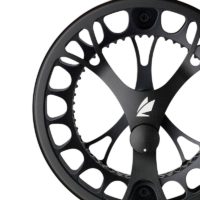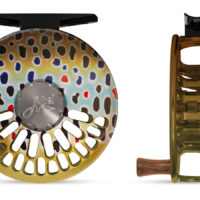Dry Creek's Guide
Choosing A Fly Reel
Some people may say that a fly reel is just a line holder and we couldn’t disagree more. While this statement may be partly true, it’s mostly false (in our opinion.) Sure when trout fishing on creeks the reel might be a line holder 99% of the time, but when fishing larger bodies of water, or when you hook into that lunker you didn’t expect to be holding in such a small piece of water, a quality reel with a smooth drag system could mean the difference between landing that trophy fish (you know that one you drove/flew all the way there for) or staring at the end of your fly less leader wondering what happened. We’ve all been there, it sucks! And if you are talking about saltwater fly fishing then we might argue that the reel is the most important part.
The nice thing about choosing which fly fishing reel to buy, is that once you know which rod you want, the reel corresponds to that number…for the most part. However, there are still a few things to consider when choosing a fly fishing reel such as drag system, arbor size, construction, weight, what it’ll be used for, and for some folks (like me) aesthetics. Below we will cover the basics to give you a better understanding when it comes to purchasing your first fly reel.

THE PARTS OF THE FLY REEL
The basic parts of a fly reel include;
- The spool (where the line is stored)
- The main body (where the spool attaches to)
- The drag system (usually built into the main body and provides resistance)
- The reel handle (to wind up fly line)
- The counter weight (used to balance the spool)
- The reel seat (the part you attach to the fly rod)
- Arbor (relates to the diameter of the reel)

$100 VS $1000. WHAT’S THE DIFFERENCE?
There’s a pretty big difference in price when it comes to reels. Typically starting around $100 for a quality reel, they can run all the way up to and over $1000. So what do you get with that difference?
First of all lets throw aesthetics aside. Yes they might mean something to you, and as I stated earlier they do to me as well, but when you can pay upwards of $400 for a beautifully hand painted reel, it kind of throws a curve ball into the situation.
Factors that affect reel pricing
- Typically reels around the $250 mark on up are made in the USA
- The drag system involved and its track record
- The amount of testing, research and retesting
- The materials used I.E. carbon fiber, machined aluminum, diecast
- The process of building the reel, machining, diecast etc
- Hand finishing to smooth out sharp edges from machining
- How tight the tolerances are (does the spool wobble on the frame)
- How much research into porting, weight, ergonomics, line clearing
- How light the reel is
Now Let’s Break Down and Talk About These Differences Some More

DRAG SYSTEM
There are 2 basic drag systems when it comes to fly reels; Disc Drag and Click & Pawl. Before disc drag reels, click & pawl were the go to option. Nowadays most reels are disc drag with only about 10% or less of the reels being click & pawl. If I were purchasing my first reel it would most definitely be a disc drag. Although I do really enjoy click & pawl reels and own and fish some myself, they aren’t as versatile as disc drag reels as you will find out below.
DISC DRAG SYSTEMS
A disc drag system uses washers to apply pressure against certain materials such as; cork, carbon, or metal surfaces. Higher end reels provide a nice smooth drag with infinite adjust-ability. Lower end reels can tend to be “jerky” or unable to keep smooth tension with a fast fish when it’s running which can lead to break -offs.
Disc drag systems;
- Able to apply more pressure to a running fish
- More adjustability
- More reels to choose from
- Sealed models for saltwater use
- Tend to be heavier than click and pawls
CLICK & PAWL
A classic click and pawl system has a “clicker” on the main part of the reel that provides resistance against a gear or disc with teeth which is built into the spool. Most click and pawl reels don’t have an adjustment to increase and decrease drag pressure, and you therefor have to use your hand to adjust pressure by “palming” the rim of the spool. Click and Pawl reels tend to also have less parts which means there is less that can go wrong with them.
Click & Pawl Systems;
- Click and Pawl Reels are lighter which can be helpful to balance out shorter rods
- Click and pawl reels have a really nice sound when fish are running
- More interactive due to using your hand to adjust pressure
- Not recommended for saltwater or big game use
OUR FAVORITE CLICK & PAWLS

REEL CONSTRUCTION
There are several different techniques and materials when it comes to fly reel construction and they are not that much different then say those of a bicycle. From the heavy, clunky, poorly shifting bikes you can find at the big box stores to the uber-light carbon fiber bikes found at your high end local shop.
When it comes down to it there has been a lot of design and manufacturing advancements made within both sports over the last few years, and features you would have found in high-end reels a decade ago are now found in lower-end models. Reels have been built overseas for decades now, and the manufacturers have got quite the hang of it.
Still, if you take pride in buying products made in the USA, you will find the highest quality reels with the tightest tolerances, smoothest drag systems, ergonomic and functional design, and finest machining available.
DIECAST
Diecast is the least expensive way to make reels, and it is done by pouring liquid metal into a mold or “die” and letting it cool. These reels tend to be the least strong and their tolerances are the lowest. Diecast has had a bad rap due to its history, but today’s diecast methods are actually letting companies build light reels at reasonable costs that wouldn’t be possible through machining methods.
Personally, there would be only one instance in which I would choose a diecast fly reel, and that would be to balance out a short creek rod where I knew it wouldn’t be placed under heavy load. However, I would personally still prefer using a click & pawl reel to overcome weight issues on a rod and to top it off, they just sound awesome!
MACHINED ALUMINUM
Machined reels are typically made from a block of aircraft grade aluminum. A high end one should have tight tolerance (no wiggle, tight spacing between moving parts) and be well built to the needs of the angler. The reels are also able to be sealed for salt water use and longevity. They can be considered lifetime reels, as you will be able to hand them down to the next generation.
CARBON FIBER
Carbon fiber is not a new material when it comes to fly fishing, but it is when it comes to reels. There are some manufacturers that are starting to use carbon fiber for spool construction which enables them to build an even lighter reel then they did before.
PORTING
Ports are all of the holes or open spaces you find on the body of the reel. These ports allow the manufacturer to relieve weight from the reel by taking away material. But you can’t just take away a bunch of material to make a cool looking design. There is a lot of thought that needs to go into porting. First you want to make sure that the reel is going to keep its structural integrity when a lot of torque is applied to it. Next you don’t want any sharp edges that could hurt your hand or end up cutting or nicking your fly line. You also don’t want to end up with a piece of line sticking out of a port when a fish is making a blistering run on you.
LARGE ARBOR REELS
Large Arbor Reels have a larger diameter than mid arbor reels. This allows you to pick up more line with each rotation of the spool which helps out with quicker line retrieval. This can be beneficial when a fish is charging at you, or when you hooked a fish and need to pick up line you have outside the reel. A large arbor reel also has lower start up inertia which will help protect you from break-offs.

DCO REEL SUGGESTIONS
It’s hard to pick out a fly reel without really knowing what type of rod it will go on. Many factors including weight and length of the rod, and what type of fishing the reel will be used for influence what type of reel to purchase. We suggest giving us a call or coming into the shop. With that said here are a few things you might want to consider;
- If you are looking for a dry fly only set-up, you might want to look into a reel that balances the rod out, or is even lighter which will naturally keep the tip of the rod down on the water.
- If you are looking for an all around trout rod, look for a reel that will balance your rod perfectly if possible.
- If you are using the rod to fish tail-waters in which case you will be holding the tip up off the water, you might want a heavier reel that will help you do so and take stress off of your arm and shoulder.
- If you have a longer or shorter length fly rod you might need a reel that is heavier or lighter than you thought.
- If you are casting a large saltwater rod all day, you want the lightest set-up possible and that includes the reel.
- If you had to choose between spending money on the reel or rod, for smaller species (trout/panfish) I would spend the money on the rod and for larger species(tarpon/pike/steelhead) I would consider focusing on the reel.



